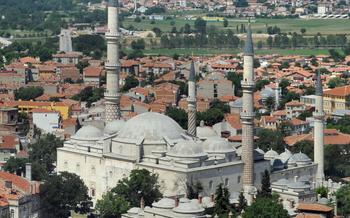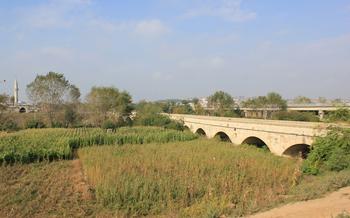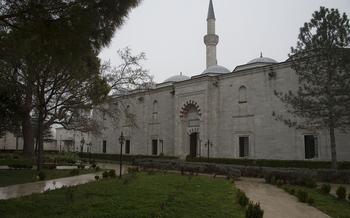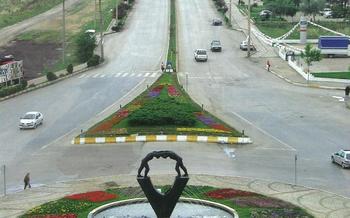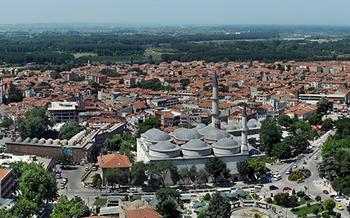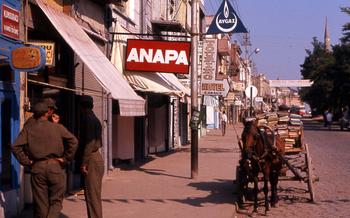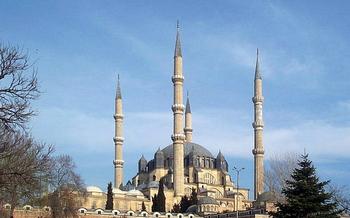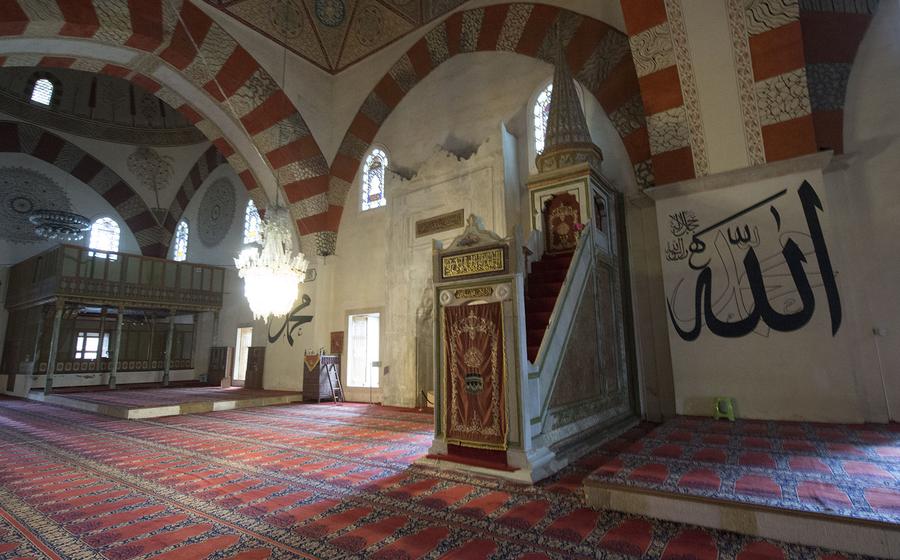
Old Mosque (Eski Camii)
- History of the Old Mosque (Eski Camii)
- Location of the Old Mosque (Eski Camii)
- Architecture of the Old Mosque (Eski Camii)
- The Courtyard of the Old Mosque (Eski Camii)
- The Prayer Hall of the Old Mosque (Eski Camii)
- The Minaret of the Old Mosque (Eski Camii)
- The Tombs of the Old Mosque (Eski Camii)
- The Museum of the Old Mosque (Eski Camii)
- Visiting Hours and Admission Fees for the Old Mosque (Eski Camii)
- Dress Code and Etiquette for Visiting the Old Mosque (Eski Camii)
- Local Customs and Traditions Related to the Old Mosque (Eski Camii)
- Nearby Restaurants and Cafes for Refreshments
- Shopping for Souvenirs and Handicrafts
- Other Historical and Cultural Sites in Edirne
- Insider Tip: Hidden Gems Around the Old Mosque (Eski Camii)
History of the Old Mosque (Eski Camii)
The Old Mosque, also known as Eski Camii, stands as a testament to the rich architectural heritage of Edirne, Turkey. Constructed in 1402 by the renowned architect Hacı İvaz Pasha, this magnificent structure is a splendid example of early Ottoman architecture. Its historical significance lies in its status as one of the earliest mosques built during the Ottoman Empire, serving as a symbol of the empire's growing influence and power. The mosque's enduring legacy has made it a cherished landmark, attracting visitors from around the world who seek to delve into the depths of Islamic history and architecture.
Location of the Old Mosque (Eski Camii)
The Old Mosque (Eski Camii) is situated in the heart of Edirne, at the crossroads of Sarayiçi and Kaleiçi neighborhoods. This strategic location reflects the mosque's historical significance as a central place of worship and community gathering. The mosque is easily accessible by foot from anywhere in the city center, making it a convenient destination for visitors and locals alike.
To reach the Old Mosque, follow Atatürk Caddesi, the main thoroughfare of Edirne, and turn onto Sarayiçi Caddesi. The mosque will be on your left, just a few steps from the intersection. The prominent landmarks surrounding the mosque, such as the Edirne Palace and the Selimiye Mosque, serve as additional guides for finding your way to this architectural gem.
In the vicinity of the Old Mosque, visitors can explore a treasure trove of historical and cultural attractions. The Edirne Palace, a magnificent example of Ottoman architecture, is just a short walk away, offering a glimpse into the grandeur of the past. The Selimiye Mosque, a masterpiece designed by the renowned architect Mimar Sinan, stands as a testament to the city's rich Islamic heritage. Other notable landmarks nearby include the Bedesten (covered market), the Great Synagogue, and the Bulgarian Church, showcasing the diverse cultural influences that have shaped Edirne over the centuries.
Architecture of the Old Mosque (Eski Camii)
The Old Mosque stands as a testament to the architectural prowess of the Ottoman era. Its exterior facade captivates the eye with its intricate brickwork, featuring alternating layers of red and white stones, a distinctive characteristic of early Ottoman architecture. The mosque's dome, a symbol of Islamic architecture, rises majestically above the skyline, its graceful curves adding a touch of elegance to the overall structure.
Stepping inside the mosque, visitors are greeted by a spacious and serene prayer hall. The interior walls are adorned with beautiful calligraphy, verses from the Quran inscribed in elegant script, adding a sacred and spiritual ambiance to the space. The mihrab, or prayer niche, located in the center of the qibla wall, is intricately carved with intricate designs and serves as a focal point for worshippers during prayer.
One of the unique architectural elements of the Old Mosque is its minaret. Unlike most mosques, which typically have one or two minarets, the Old Mosque boasts four slender minarets, each rising gracefully from the corners of the building. The minarets, adorned with intricate tilework and topped with elegant balconies, add a distinctive touch to the mosque's profile and serve as a symbol of its grandeur.
Comparing the Old Mosque with other mosques in Turkey, it is evident that its architectural style is representative of the early Ottoman period. The use of red and white stones in the exterior facade, the graceful dome, and the intricate calligraphy inside the prayer hall are all characteristic features of this era. The mosque's unique four-minaret design sets it apart from other mosques in Turkey, making it a valuable example of early Ottoman architecture.
The Courtyard of the Old Mosque (Eski Camii)
The courtyard of the Old Mosque (Eski Camii) is a serene and spacious area that adds to the overall tranquility of the mosque. It is surrounded by a covered arcade supported by slender columns, creating a shaded walkway for visitors to stroll and admire the intricate details of the architecture. In the center of the courtyard stands a beautifully decorated fountain, which serves as a place for ablution before prayer. The courtyard also features a number of smaller fountains and water basins, adding to the tranquil atmosphere. In Islamic architecture, the courtyard plays a significant role as a social and communal space, where people can gather for religious discussions, meetings, and community events. It is a place of contemplation and reflection, where visitors can find peace and serenity amidst the bustling city.
The Prayer Hall of the Old Mosque (Eski Camii)
The prayer hall of the Old Mosque (Eski Camii) is the heart of the mosque, where Muslims gather to perform their daily prayers. It is a spacious and elegant space, measuring approximately 20 meters in length and 15 meters in width. The hall can accommodate up to 500 worshippers, making it one of the largest prayer halls in Edirne.
The focal point of the prayer hall is the mihrab, a prayer niche that indicates the direction of Mecca. The mihrab of the Old Mosque is a beautiful example of Islamic craftsmanship, featuring intricate carvings and colorful tiles. It is flanked by two columns that support the arches of the ceiling.
To the right of the mihrab is the minbar, a pulpit from which the imam delivers sermons and leads prayers. The minbar of the Old Mosque is made of wood and features fine carvings and inlaid mother-of-pearl decorations.
The walls of the prayer hall are decorated with verses from the Quran, as well as with intricate geometric and floral patterns. The ceiling is supported by a series of arches that create a sense of height and grandeur. The overall effect is one of beauty and serenity, making the prayer hall a conducive space for contemplation and worship.
The prayer hall of the Old Mosque is not only a place of worship but also a repository of Islamic art and architecture. It is a testament to the skill and dedication of the craftsmen who built it, and it continues to inspire and awe visitors to this day.
The Minaret of the Old Mosque (Eski Camii)
The minaret of the Old Mosque (Eski Camii) is an impressive architectural feature that stands tall and majestic, guiding the faithful to prayer and symbolizing the importance of the mosque in the cityscape. Constructed from the same fine masonry as the rest of the mosque, the minaret boasts a cylindrical shape and a height that commands attention.
The minaret displays intricate detailing and ornamentation, showcasing the skill and craftsmanship of the builders. Its surface is adorned with elegant carvings and intricate designs, adding to its visual appeal. The structure is divided into three distinct sections, each featuring a unique design and decorative elements.
The minaret's balconies, known as şerefes, are particularly striking. Each balcony is supported by intricately carved brackets and features arched openings that allow the muezzin to call the faithful to prayer. The balconies offer breathtaking views of the surrounding city, providing visitors with a unique perspective and a chance to appreciate the mosque's grandeur from above.
The minaret serves as a symbol of the mosque's spiritual and architectural significance, guiding the faithful to prayer and reminding them of the presence of the divine. It stands as a testament to the rich history and architectural heritage of Edirne, adding to the city's allure and fascination.
The Tombs of the Old Mosque (Eski Camii)
In the serene courtyard of the Old Mosque (Eski Camii) lie several tombs that hold the remains of notable individuals who played significant roles in the history of Edirne and beyond. The most prominent among these is the tomb of Sultan Murad II, the fifth sultan of the Ottoman Empire. Known for his military prowess and his patronage of the arts, Sultan Murad II ruled from 1421 until his abdication in 144He chose Edirne as his capital city and made significant contributions to its development and prosperity.
Other notable individuals buried in the tombs of the Old Mosque include Şehzade Mustafa, the son of Sultan Suleiman the Magnificent, who was tragically executed on the orders of his father; and Grand Vizier Sokollu Mehmed Pasha, an influential figure in the Ottoman court during the reign of Sultan Selim II.
These tombs serve as a reminder of the rich history and cultural heritage of Edirne and the Ottoman Empire. Visitors can pay their respects to these important figures and learn about their contributions to the city and the broader region. The tombs are not only architectural landmarks but also hold historical and cultural significance, providing a glimpse into the lives and legacies of those who shaped the course of history.
The Museum of the Old Mosque (Eski Camii)
The Old Mosque in Edirne houses a small yet fascinating museum that delves into the rich history and cultural significance of the mosque and the surrounding area. The museum is located within the mosque complex and can be accessed during visiting hours.
Exhibits and Artifacts
The museum showcases a variety of exhibits and artifacts that provide insights into the mosque's construction, architectural features, and religious significance. Visitors can admire intricate tilework, calligraphy inscriptions, and decorative elements that adorned the mosque's interior. There are also displays of historical documents, manuscripts, and photographs that chronicle the mosque's evolution over the centuries.
History and Significance
The museum offers a glimpse into the history of the Old Mosque, from its initial construction in the 15th century to its subsequent renovations and expansions. Visitors can learn about the mosque's role as a center of religious worship and community gatherings, as well as its association with important historical figures and events. The museum also highlights the mosque's architectural significance, showcasing its unique features and its influence on Islamic architecture in the region.
Educational Programs and Activities
The museum regularly organizes educational programs and activities to engage visitors of all ages. Guided tours are available in multiple languages, providing in-depth information about the mosque's history, architecture, and cultural significance. There are also interactive exhibits and workshops that allow visitors to learn about Islamic art, calligraphy, and traditional crafts.
Accessibility for Visitors
The Museum of the Old Mosque is committed to providing a welcoming and accessible environment for all visitors. The museum is wheelchair-accessible, and there are ramps, elevators, and accessible restrooms throughout the complex. Multilingual signage and audio guides are also available to assist visitors from different language backgrounds.
Visiting Hours and Admission Fees for the Old Mosque (Eski Camii)
The Old Mosque (Eski Camii) welcomes visitors from all backgrounds and cultures, offering an opportunity to explore its architectural wonders and religious significance. To ensure a smooth and respectful visit, the mosque adheres to specific visiting hours and admission fees:
-
Opening and Closing Times: The Old Mosque (Eski Camii) is open to visitors daily, allowing flexibility in planning your visit. Its doors open at 9:00 AM and remain accessible until 6:00 PM, providing ample time to explore the mosque's exterior and interior features.
-
Ticket Prices: Admission to the Old Mosque (Eski Camii) is subject to a modest entrance fee, ensuring the preservation and maintenance of this historic site. Tourists and foreign visitors are required to pay a slightly higher fee compared to Turkish citizens and residents.
-
Free Admission Days or Periods: To encourage accessibility and promote cultural exchange, the Old Mosque (Eski Camii) offers free admission on certain days or during specific periods. These designated times provide an opportunity for visitors to experience the mosque's beauty without any financial burden.
-
Discounts and Concessions: Students, children, and senior citizens are eligible for discounted admission fees at the Old Mosque (Eski Camii). Presenting a valid form of identification, such as a student ID or passport, allows individuals to take advantage of these concessions.
Dress Code and Etiquette for Visiting the Old Mosque (Eski Camii)
When visiting the Old Mosque (Eski Camii) or any other mosque in Turkey, it is important to dress respectfully and observe proper etiquette to show respect for the religious significance of the site.
- Attire:
- Men: Modest clothing that covers the knees and shoulders is recommended. Avoid shorts, tank tops, and revealing clothing.
-
Women: Women should wear a headscarf to cover their hair as a sign of respect. Long, loose clothing that covers the body is also appropriate.
-
Footwear:
-
Remove your shoes before entering the prayer hall. Place them neatly on the designated shoe racks or shelves provided.
-
Behavior:
- Maintain a respectful demeanor inside the mosque. Avoid loud conversations, laughter, or any behavior that may disturb others.
-
Obey the signs and instructions posted within the mosque. For example, some areas may be designated for prayer only, and visitors should not enter those areas.
-
Photography:
-
Photography is generally permitted within the mosque, but it is important to be respectful of worshippers. Avoid taking photos of people without their consent, and turn off the flash when taking photos.
-
Silence:
- Keep your voice low and avoid unnecessary talking during prayer times. If you need to speak, do so quietly and respectfully.
Local Customs and Traditions Related to the Old Mosque (Eski Camii)
The Old Mosque (Eski Camii) in Edirne holds a significant place in the hearts of local Muslims, who observe various customs and traditions related to the mosque. During the holy month of Ramadan, the mosque comes alive with special prayers, community gatherings, and charitable activities. Locals participate in "iftar" meals, breaking their fast together in the courtyard or nearby homes.
Throughout the year, the mosque hosts religious ceremonies and festivals that showcase the rich Islamic heritage of Edirne. These events, such as Mawlid al-Nabi (the Prophet Muhammad's birthday) and Eid al-Fitr (the end of Ramadan), attract large crowds of worshippers and visitors.
Local beliefs and superstitions associated with the mosque add to its mystical aura. Some believe that praying at the mosque during certain times or seeking blessings at the tombs of notable individuals buried there can bring good fortune and spiritual fulfillment. Locals also have a deep respect for the mosque's architecture and often admire its beauty and craftsmanship, seeing it as a symbol of their cultural identity.
Respecting local customs and traditions is essential when visiting the Old Mosque (Eski Camii). Visitors should dress modestly, remove their shoes before entering the prayer hall, and maintain a respectful silence inside the mosque. Taking photographs or videos is usually permitted, but it's important to ask for permission and be mindful of the privacy of others. By observing local customs and traditions, visitors can show their respect for the religious and cultural significance of the Old Mosque (Eski Camii).
Nearby Restaurants and Cafes for Refreshments
After a fulfilling visit to the Old Mosque, you may want to savor the local cuisine or relax with a refreshing beverage. Edirne offers a diverse culinary scene with options ranging from traditional Turkish dishes to international fare.
For an authentic Turkish experience, head to one of the many köfte (meatball) restaurants in the city. Köfteci Ali Baba and Köfteci Erol Usta are popular choices among locals. Indulge in the succulent meatballs served with rice, salad, and grilled vegetables.
If you prefer something lighter, try pide (Turkish flatbread) or lahmacun (Turkish pizza). These savory treats are topped with minced meat, vegetables, and spices, and are a delicious and affordable option for a quick bite.
For a taste of the sea, head to one of the fish restaurants along the Tunca River. Enjoy freshly caught fish grilled to perfection, accompanied by traditional Turkish mezes (appetizers) such as cacık (cucumber-yogurt sauce) and hummus (chickpea dip).
Vegetarians and vegans will find plenty of options in Edirne. Many restaurants offer a variety of meze platters featuring grilled vegetables, stuffed grape leaves, and fresh salads. Falafel and muhammara (roasted red pepper and walnut dip) are also popular choices.
For a sweet treat, try the famous Edirne cheese cake. This unique dessert is made with a combination of filo pastry, cheese, and sugar syrup, and is a must-try for visitors to the city.
When it comes to beverages, Turkish coffee is a must-try. Enjoy a cup of this strong, aromatic coffee at one of the many coffeehouses in the city. Tea lovers can indulge in traditional Turkish tea, served in small tulip-shaped glasses.
Whether you're looking for a hearty meal or a quick snack, Edirne offers a variety of dining options to cater to every taste and budget. Don't miss the opportunity to sample the local cuisine and enjoy a refreshing beverage after your visit to the Old Mosque.
Shopping for Souvenirs and Handicrafts
After exploring the Old Mosque and its surroundings, you may want to take home a souvenir or two to remember your visit. Edirne offers a variety of shopping options for tourists, from traditional markets to modern shopping malls.
The most popular place to shop for souvenirs is the Kapalı Çarşı (Grand Bazaar), located in the heart of the city. Here, you can find a wide range of traditional Turkish handicrafts, including carpets, pottery, jewelry, and leather goods. The bazaar is a great place to haggle for prices and find unique items that you won't find anywhere else.
If you're looking for something more specific, you can visit the Arasta Bazaar, which specializes in antiques and vintage items. Here, you can find everything from old coins and stamps to antique furniture and jewelry.
For those who prefer modern shopping malls, the Edirne Forum is a good option. This mall offers a variety of shops, including international brands, Turkish retailers, and a food court.
No matter where you choose to shop, be sure to bargain for prices. Haggling is a common practice in Turkey, and you can often get a good deal if you're willing to negotiate.
Here are some tips for bargaining in Turkey:
- Be polite and respectful.
- Start by offering a price that is significantly lower than the asking price.
- Be prepared to walk away if the seller is not willing to negotiate.
- Be patient and persistent.
With a little patience and effort, you can find some great souvenirs and handicrafts in Edirne.
Other Historical and Cultural Sites in Edirne
Beyond the Old Mosque (Eski Camii), Edirne boasts a wealth of historical and cultural treasures that captivate visitors. Among them, the Selimiye Mosque, a masterpiece of Ottoman architecture, stands out with its soaring dome and graceful minarets. Built in the 16th century, this architectural marvel is a testament to the city's rich past and continues to awe visitors with its grandeur.
For history buffs, the Edirne Museum offers a captivating glimpse into the city's storied past. Housed in a former palace, the museum showcases a diverse collection of artifacts, including ancient coins, pottery, and manuscripts that narrate the city's evolution from a Roman settlement to a thriving Ottoman capital.
Those seeking a unique cultural experience should immerse themselves in the vibrant atmosphere of the Edirne Bazaar. This bustling marketplace offers a tantalizing array of local delicacies, handcrafted souvenirs, and traditional textiles, providing a glimpse into the city's vibrant commercial heritage.
For a serene respite, stroll along the banks of the Tunca River, which meanders through the heart of Edirne. Admire the picturesque scenery, dotted with ancient bridges and lush greenery, as you revel in the tranquility of this natural haven.
Edirne also serves as an ideal base for exploring the surrounding region. Embark on a day trip to the ancient city of Troy, immortalized in Homer's epic poems, and discover the ruins of this legendary site. Alternatively, venture to the pristine beaches of Saros Bay, where you can bask in the sun, swim in the crystal-clear waters, and enjoy a variety of water sports.
Whether you're a history enthusiast, a culture seeker, or simply seeking a relaxing getaway, Edirne offers an abundance of experiences that will leave you enchanted.
Insider Tip: Hidden Gems Around the Old Mosque (Eski Camii)
For those seeking hidden gems and unique experiences, the area surrounding the Old Mosque (Eski Camii) offers a treasure trove of lesser-known attractions. Photography enthusiasts can discover secret spots that offer breathtaking perspectives of the mosque and its surroundings. Local eateries frequented by residents serve authentic Turkish cuisine, providing a taste of the city's culinary delights. Hidden courtyards and gardens offer a tranquil escape from the bustling streets, inviting visitors to relax and soak in the serene atmosphere. Additionally, exploring the narrow alleys and side streets around the mosque reveals lesser-known historical sites, each with its own story to tell. By venturing off the beaten path, travelers can uncover the hidden gems of Edirne and gain a deeper understanding of its rich history and culture.

